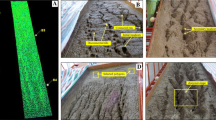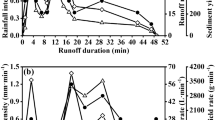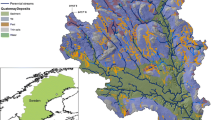Abstract
Soil erosion remains a critical concern worldwide, and predicting the occurrence, location, and evolution of rills on hillslopes and agricultural landscapes remains a fundamental challenge in resource management. To address these questions, a relatively large soil-mantled experimental landscape was subjected to continuous rainfall and episodes of base-level lowering to force the development of a rill network system, and high-resolution digital technologies were used to quantify its evolution over time and space. These results show that waves of degradation and landscape incision occurred in response to base-level lowering, where headcut development and its upstream migration produced a fourth-order rill network. Stream order indices derived for this incised rill network confirm that this pattern emerges relatively early in time, and it remains relatively unchanged despite continued application of rainfall and additional base-level lowering. Using the same digital technologies, a surface drainage system was defined and mapped on the landscape prior to any soil erosion and rill development, and similar network indices also were derived. These results show that network characteristics and organization of this surface drainage system, as well as its location in space, were in very close agreement with the subsequent incised rill network following base-level lowering. It is demonstrated here that rill networks formed in this experiment are strongly conditioned by surface drainage patterns prior to any significant soil erosion and that the location of rill networks can be accurately delineated through analysis of the high-resolution digital terrain.









Similar content being viewed by others
References
Assouline S (2004) Rainfall-induced soil surface sealing: a critical review of observations, conceptual models, and solutions. Vadose Zone J 3:570–591
Bennett SJ, Casalí J, Robinson KM, Kadavy KC (2000) Characteristics of actively eroding ephemeral gullies in an experimental channel. Trans Am Soc Agric Eng 43:641–649
Brunton DA, Bryan RB (2000) Rill network development and sediment budgets. Earth Surf Process Landf 25:783–800
Bryan RB (ed) (1990) Knickpoint evolution in rillwash. In: Soil erosion—experiments and models. Catena Supplement 17, Catena Verlag, Cremlingen-Destedt, p 111–132
Casalí J, López JJ, Giráldez JV (1999) Ephemeral gully erosion in Southern Navarra (Spain). Catena 36:65–84
Casalí J, Bennett SJ, Robinson KM (2000) Processes of ephemeral gully erosion. Int J Sedim Res 15:31–41
Chandler JH, Shiono K, Ponnambalam R, Lane S (2001) Measuring flume surfaces for hydraulics research using a Kodak DCS460. Photogramm Rec 17:39–61
Douglass J, Schmeeckle M (2007) Analogue modeling of transverse drainage mechanisms. Geomorphology 84:22–43
Dunkerley D (2004) Flow threads in surface run-off: implications for the assessment of flow properties and friction coefficients in soil erosion and hydraulics investigations. Earth Surf Process Landf 29:1011–1026
Favis-Mortlock D (1998) A self-organizing dynamic systems approach to the simulation of rill initiation and development of hillslopes. Comput Geosci 24:353–372
Favis-Mortlock DT, Boardman J, Parsons AJ, Lascelles B (2000) Emergence and erosion: a model for rill initiation and development. Hydrol Process 14:2173–2205
Flanagan DC, Nearing MA (eds) (1995) USDA-Water erosion prediction project hillslope profile and watershed model documentation. NSERL report no. 10. USDA-ARS National Soil Erosion Research Laboratory, West Lafayette
Gardner TW (1983) Experimental study of knickpoint and longitudinal profile evolution in cohesive, homogenous material. Geol Soc Am Bull 94:664–672
Gilley JE, Elliot WJ, Laflen JM, Simanton JR (1993) Critical shear stress and critical flow rates for initiation of rilling. J Hydrol 142:251–271
Gómez JA, Darboux F, Nearing MA (2003) Development and evolution of rill networks under simulated rainfall. Water Resour Res 39:1148. doi:10.1029/2002WR001437
Gordon LM, Bennett SJ, Bingner RL, Theurer FD, Alonso CV (2007) Simulating ephemeral gully erosion in AnnAGNPS. Trans Am Soc Agric Biol Eng 50:857–866
Gordon LM, Bennett SJ, Alonso CV, Bingner RL (2008) Modeling long-term soil losses on agricultural fields due to ephemeral gully erosion. J Soil Water Conserv 63(4):173–181
Gordon LM, Bennett SJ, Wells RR (2012) Response of a soil-mantled experimental landscape to exogenic forcing. Water Resour Res 48:W10514. doi:10.1029/2012WR012283
Govers G, Giménez R, Van Oost K (2007) Rill erosion: exploring the relationship between experiments, modelling and field observations. Earth Sci Rev 84:87–102
Helming K, Römkens MJM, Prasad SN, Sommer H (1998) Erosional development of small scale drainage networks. In: Hergarted S, Neugebauer H (eds) Process modeling and landform evolution. Springer, New York, pp 123–146
Heng BCP, Chandler JH, Armstrong A (2010) Applying close range digital photogrammetry in soil erosion studies. Photogramm Rec 25:240–265
Howard AD (1971) Simulation of stream networks by headward growth and branching. Geogr Anal 3:29–50
Keller EA, DeVecchio DE (2012) Earth’s processes as hazards, disasters, and catastrophes, 3rd edn. Prentice Hall, Upper Saddle River 528 pp
Kirchner JW (1993) Statistical inevitability of Horton’s laws and the apparent randomness of stream channel networks. Geology 21:591–594
Kirchner JW (1994) Statistical inevitability of Horton’s laws and the apparent randomness of stream channel networks: reply. Geology 22:574–575
Lal R (2001) Soil degradation by erosion. Land Degrad Dev 12:519–539
Lal R (2009) Soils and food sufficiency: a review. Agron Sustain Dev 29:113–133
Lal R, Pimentel D (2008) Soil erosion: a carbon sink or source? Science 319:1040–1042
Lei T, Nearing MA, HaghighiK K, Bralts VF (1998) Rill erosion and morphological evolution: a simulation model. Water Resour Res 34:3157–3168
Merritt E (1984) The identification of four stages during micro-rill development. Earth Surf Process Landf 9:493–496
Momm HG, Bingner RL, Wells RR, Rigby JR, Dabney SM (2013) Effect of topographic characteristics on compound topographic index for identification of gully channel initiation locations. Trans Am Soc Agric Biol Eng 56:523–537
Montgomery DR (2007) Soil erosion and agricultural sustainability. Proc Natl Acad Sci 104:13268–13272
Morgan RPC, Quinton JN, Smith RE, Govers G, Poesen JWA, Auerswald K, Chisci G, Torri D, Styczen ME (1998) The European Soil Erosion Model (EUROSEM): a dynamic approach for predicting sediment transport from fields and small catchments. Earth Surf Process Landf 23:527–544
National Research Council (2009) Frontiers in soil science research: report of a workshop. Steering committee for frontiers in soil science research board on international scientific organizations policy and global affairs. The National Academies Press, Washington, p 68
National Research Council (2010) Understanding the changing planet: strategic directions for the geographical sciences, committee on strategic directions for the geographical sciences in the next decade, board on earth sciences and resources, division on earth and life studies. National Academy of Sciences, The National Academies Press, Washington, DC, p 155
Nearing MA, Romkens MJM, Norton LD, Stott DE, Rhoton FE, Laflen JM, Flanagan DC, Alonso CV, Bingner RL, Dabney SM, Doering OC, Huang CH, McGregor KC, Simon A (2000) Discussion of “Measurements and models of soil loss rates”. Science 290:1300–1301
Papanicolaou AN, Sanford JT, Dermisis DC, Mancilla GA (2010) A 1-D morphodynamic model for rill erosion. Water Resour Res 46:W09541. doi:10.1029/2009WR008486
Parker RS (1977) Experimental study of basin evolution and its hydrologic implications. Ph.D. dissertation. Colorado State University, Fort. Collins
Pelletier JD (2003) Drainage basin evolution in the rainfall erosion facility: dependence on initial conditions. Geomorphology 53:183–196
Pimentel D (2006) Soil erosion: a food and environmental threat. Environ Dev Sustain 8:119–137
Pimentel D, Harvey C, Resosudarmo P, Sinclair K, Kurz D, McNair M, Crist S, Shpritz L, Fitton L, Saffouri R, Blair R (1995) Environmental and economic costs of soil erosion and conservation benefits. Science 267:1117–1123
Poesen J, Vandaele K, Van Wesemael B (1996) Contribution of gully erosion to sediment production on cultivated lands and rangelands. In: Walling DE, Webb BW (ed) Erosion and sediment yield: global and regional perspectives. IAHS. Publ. no. 236, Wallingford, p 251–266
Poesen J, Nachtergaele J, Verstraeten G, Valentin C (2003) Gully erosion and environmental change: importance and research needs. Catena 50:91–133
Rauws G, Govers G (1988) Hydraulic and soil mechanical aspects of rill generation on agricultural soils. J Soil Sci 39:111–124
Renard KG, Foster GR, Weesies GA, McCool DK,Yoder DC (1997) Predicting soil erosion by water: a guide to conservation planning with the revised universal soil loss equation (RUSLE). USDA Agric. Handbk. no. 703, Washington, DC
Rieke-Zapp DH, Nearing MA (2005) Slope shape effects on erosion: a laboratory study. Soil Sci Soc Am J 69:1463–1471
Rodriguez-Iturbe I, Rinaldo AR, Rigon R, Bras RL, Marani A, Ijjász-Váquez E (1992) Energy dissipation, runoff production, and the three-dimensional structure of river basins. Water Resour Res 28:1095–1103
Römkens MJM, Prasad SN, Gerits JJP (1997) Soil erosion modes of sealing soils: a phenomenological study. Soil Technol 11:31–41
Römkens MJM, Helming K, Prasad SN (2001) Soil erosion under different rainfall intensities, surface roughness, and soil water regimes. Catena 46:103–123
Sidorchuk A (1999) Dynamic and static models of gully erosion. Catena 37:401–414
Slattery MC, Bryan RB (1992) Hydraulic conditions for rill incision under simulated rainfall: a laboratory experiment. Earth Surf Process Landf 17:127–146
Smith RE, Quinton J, Goodrich DC, Nearing M (2010) Soil-erosion models: where do we really stand? Earth Surf Process Landf 35:1344–1348. doi:10.1002/esp.1985
Tarboton DG, Ames DP (2001) Advances in the mapping of flow networks from digital elevation data. In: Phelps D, Shelke G (eds) World water and environmental resources congress. ASCE, Orlando, May 20–24
Tarboton DG, Bras RL, Rodriguez-Iturbe I (1988) The fractal nature of river networks. Water Resour Res 24:1317–1322
Trimble SW, Crosson P (2000) US soil erosion rates—myth and reality. Science 289:248–250
Troutman BM, Karlinger MR (1994) Statistical inevitability of Horton’s laws and the apparent randomness of stream channel networks: comment. Geology 22:573–574
Uri ND, Lewis JA (1999) Agriculture and the dynamics of soil erosion in the United States. J Sustain Agric 14:63–82
US Environmental Protection Agency (1998) National water quality inventory: 1998 report to congress. Report EPA841-R-00-001. Washington
US Environmental Protection Agency (2000) The Quality of our nation’s waters. A summary of the National Water Quality Inventory: 1998 report to congress. Report EPA841-S-00-001. Washington
Valentin C, Poesen J, Li Y (2005) Gully erosion: impacts, factors and control. Catena 63:132–153
Van Oost K, Quine TA, Govers G, De Gryze S, Six J, Harden JW, Ritchie JC, McCarty GW, Heckrath G, Kosmas C, Giraldez JV, Marques da Silva JR, Merckx R (2007) The impact of agricultural soil erosion on the global carbon cycle. Science 318:626–629
Wilson BN, Storm DE (1993) Fractal analysis of surface drainage networks for small upland areas. Trans Am Soc Agric Eng 36:1319–1326
Yao C, Lei T, Elliot WJ, McCool DK, Zhao J, Chen S (2008) Critical conditions for rill initiation. Trans Am Soc Agric Biol Eng 51:107–114
Acknowledgments
We thank Toby Gardiner and Peter Ashmore for kindly providing technical guidance on photogrammetry, Rorke Bryan for the flume, and the two anonymous reviewers and guest editors for their constructive comments. This research was partially supported by the USDA-ARS (Specific Research Agreement No. 58-6408-3-028) and NSF (EAR 0640617, BCS 1359904).
Author information
Authors and Affiliations
Corresponding author
Rights and permissions
About this article
Cite this article
Bennett, S.J., Gordon, L.M., Neroni, V. et al. Emergence, persistence, and organization of rill networks on a soil-mantled experimental landscape. Nat Hazards 79 (Suppl 1), 7–24 (2015). https://doi.org/10.1007/s11069-015-1599-8
Received:
Accepted:
Published:
Issue Date:
DOI: https://doi.org/10.1007/s11069-015-1599-8




